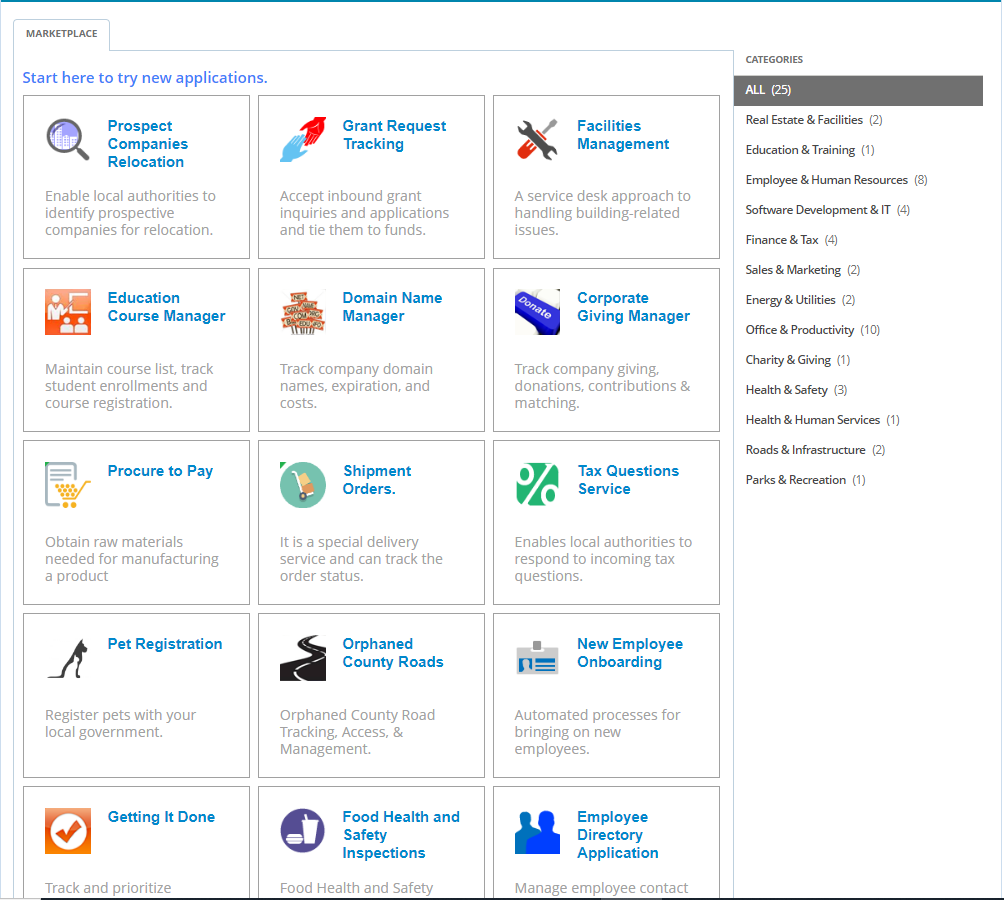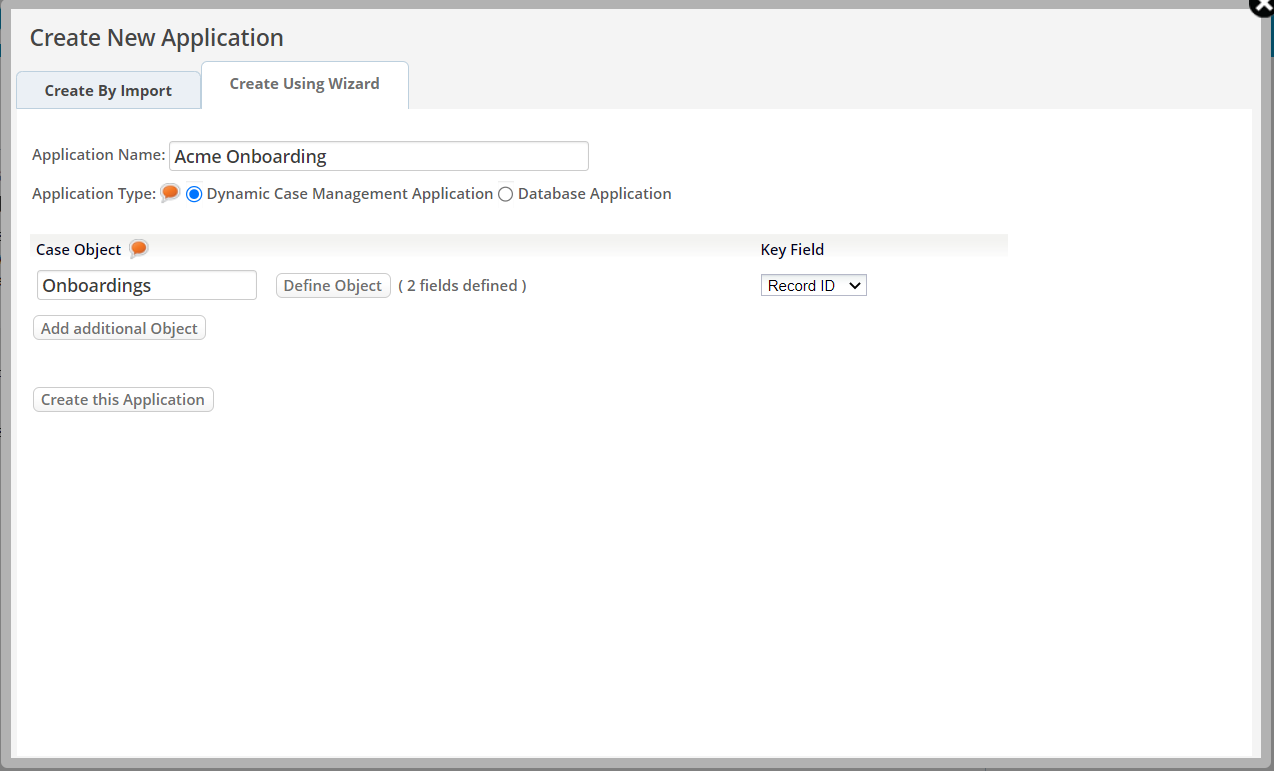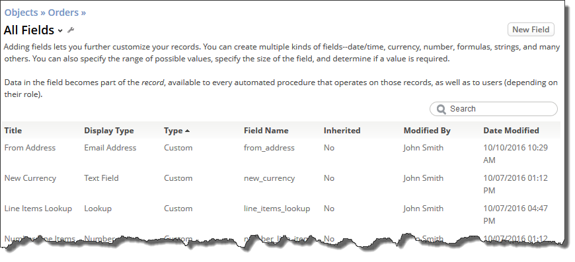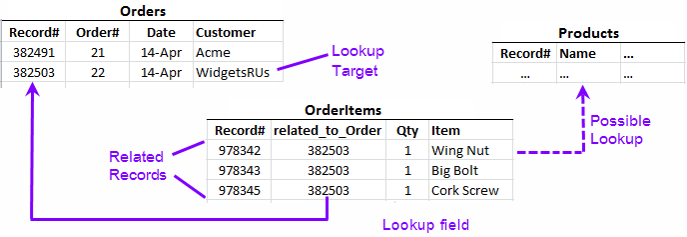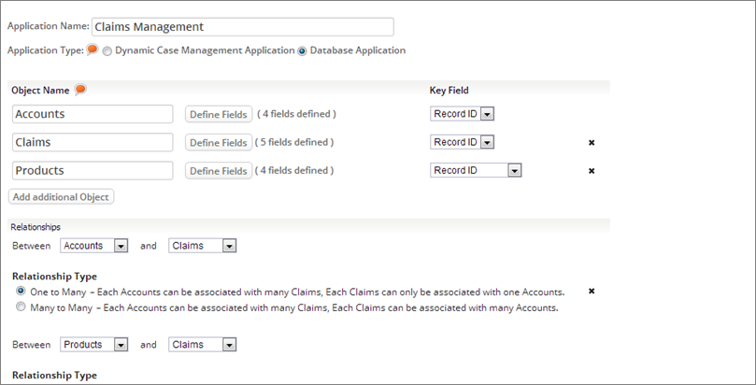Difference between revisions of "Exercise 02: Creating Applications and Defining Objects"
From AgileApps Support Wiki
Wikieditor (talk | contribs) |
Wikieditor (talk | contribs) |
||
| (15 intermediate revisions by the same user not shown) | |||
| Line 1: | Line 1: | ||
==Introduction== | |||
===Types of AgileApps Applications=== | |||
:* '''Dynamic Case Management (DCM) Application''' | |||
:** Automates the handling of Cases, Incidents, or Investigations | |||
:** Allows for process variants for dynamic behavior | |||
:* '''Service Desk Application''' | |||
:** An example of a Dynamic Case Management system | |||
:** Specialized to provide additional features for customer support | |||
:* '''Database (DB) Application''' | |||
:** A generic Web-based database application | |||
:** Like a spreadsheet but with extra capabilities | |||
===Dynamic Case Management (DCM) Application=== | |||
The front-line of customer, partner, and employee engagement | |||
A case is a unit of work | |||
A case Object can have a different name (other than “case”) | |||
Examples: | |||
:* '''Service Requests''' | |||
:** Customer Service | |||
:** Claims Management | |||
:** Employee, Supplier, and Partner on-boarding & off-boarding | |||
:** Complex, high-value proposals | |||
:* '''Incident Management''' | |||
:** Order Exception Management | |||
:** Complaint Management | |||
:** Dispute Resolution | |||
:** Employee Health and Safety | |||
:* '''Investigations''' | |||
:** Customer Analysis | |||
:** Regulation, Audit requests, and tracking | |||
:** Compliance Tracking | |||
:** Fraud investigations | |||
===Three Ways of Creating an Application=== | |||
:* Start with a sample application and customize it | |||
:* Create a new application: | |||
:** Import your Object and data from a spreadsheet | |||
:* Create a new application: | |||
:** Use the Wizard to start “from scratch” | |||
===Creating an Application from a Sample Application=== | |||
:* Select from many pre-built applications in the Marketplace | |||
:** Software AG owned source of pre-built applications | |||
:** Download for use with cloud tenants only | |||
:** Number of the available application may vary from time to time | |||
<br><br>[[File:Marketplace_Applications.PNG|800px]]<br><br> | |||
:* Customize as required | |||
===Create a New Application by Importing Spreadsheet Data=== | |||
:* Object structure and Data only – no formulas | |||
:* Paste spreadsheet data | |||
<br><br>[[File:Paste_Spreadsheet_Data.png|700px]]<br><br> | |||
:* OR: Load from File | |||
<br><br>[[File:Load_From_File.png|700px]]<br><br> | |||
===Creating a New Application Using the Wizard=== | |||
:* Use to create a custom application from scratch | |||
:* You specify Object definitions by filling in the form | |||
<br><br>[[File:Create New Application Create_Using_Wizard Acme Onboarding.PNG|900px]]<br> | |||
:* Hint: | |||
:* Type a Field Label carefully (because it is used to create the field name) | |||
:** The label can change - the internal name never does | |||
===Components of an AgileApps Application=== | |||
:* An AgileApps application is composed of Objects and Object Relationships | |||
:* An AgileApps application may also include: | |||
:** Forms, Web Forms, Pages, Views, Templates, Reports, Dashboards (display data) | |||
:** Validations, Business Rules | |||
:** Macros, Processes | |||
:* An AgileApps application can integrate global and external system elements: | |||
:** Web Services, Global Picklists | |||
:** Java classes | |||
:** Web Tabs | |||
===AgileApps is Built on a Relational Database=== | |||
:* The AgileApps platform is built on MySQL | |||
:* Similar to a spreadsheet <br><br>[[File:Spreadsheet.png|500px]]<br><br> | |||
:* A relational database contains tables - selected data is shown in a View<br><br>[[File:All_Active_Cases.png|500px]]<br><br> | |||
===An AgileApps Object is an Enhanced Database Table=== | |||
:* An AgileApps Object consists of a database table, plus: | |||
:** Forms and Layout Rules | |||
:** Field and Form scripts | |||
:** Email & Document templates | |||
:** Macro-actions, Validations, Processes | |||
<br><br>[[File:All_Fields.png|800px]]<br><br> | |||
:* When you define a new Object: | |||
:** internal table and default Forms are automatically generated | |||
:** Object is added as a new tab to you application by default | |||
===Forms to Display Object Fields=== | |||
:* As a developer/administrator at design-time: | |||
:** Modify (default) Forms in the graphic Form editor | |||
:** Create/clone new Forms | |||
:** Assign them to Application Roles | |||
:** Dynamically modify their behavior | |||
:* As a User (Agent) at runtime: | |||
:** Use Forms to view/enter data for a record | |||
===Defining Fields for an Object=== | |||
:* Mandatory label | |||
:* Displayed on the form | |||
:* Display Type (Field data type) | |||
:* Required or not | |||
:** Field Name (internal) | |||
:** Auto-filled | |||
:** Must begin with an alphabetic character | |||
:** Can contain alphabetical and numeric characters, and underscores | |||
:** Cannot be a reserved word (ex. BLOB, BINARY) | |||
:** Must be unique within the Object | |||
<br><br>[[File:New_Field.png|800px]]<br><br> | |||
===Lookup Fields=== | |||
:* A Lookup is a field that points to a record of another Object | |||
:* A Lookup field defines a Many-to-One relationship | |||
:* Example: Many OrderItems point to a single Order: | |||
<br><br>[[File:Lookup_Fields.png|800px]]<br><br> | |||
:* Notes: | |||
:** There could be a Products Object, as well (depending on the design) | |||
:** When you specify an Object Relationship in the application wizards, the Lookup field is created for you | |||
:** You can also create the Lookup fields yourself | |||
:* Important terms: Lookup, target, related records, Object Relationship | |||
===Lookup Fields and Object Relationships=== | |||
Object Relationships can be configured: | |||
:* in the application wizard | |||
:* by adding child Objects to an Object | |||
:* by adding Lookup fields | |||
<br><br>[[File:application_wizard.png|800px]]<br><br> | |||
===Types of Object Relationships=== | |||
:* '''One-to-Many''' | |||
:** Many related records can point to one target record | |||
:* '''One-to-One''' | |||
:** There can be one and only one related record for each target record | |||
:** Uncommon: | |||
:*** Define a one-to-many relationship | |||
:*** Use program logic to restrict record creation | |||
:* '''Many-to-Many''' | |||
:** Example: Cases and Contributors | |||
:** One Case has many Contributors, one Contributor works on many Cases | |||
:** Internally, they are managed using junction Objects | |||
:** A few good things about the platform are: | |||
:*** The platform makes them almost entirely invisible | |||
:*** When looking at a Case, you see all related Contributors | |||
:*** When looking at a Contributor, you see all related Cases | |||
===Additional Concepts Related to Lookups=== | |||
:* '''Rollup Summary Fields''' | |||
:** Can combine information from multiple records of a related Object | |||
:** Get a record Count, Sum, Average, Max, or Min value from those records (see ch. 4) | |||
:* '''Record Locators''' | |||
:** A Lookup field contains a pointer to a record (generally a record#) | |||
:*** Record Locators tell which fields to display to identify a record when: | |||
:***: a) Performing a Lookup | |||
:***: b) Displaying the record | |||
:***: c) Searching | |||
:*** Example: When selecting a User, you see First Name + Last Name | |||
:* '''Lookup-derived Fields''' | |||
:** Lookup-derived fields are copies of fields contained in a target record a Lookup points to | |||
:*** Example: OrderItems contains a Lookup to a Products table | |||
:*** The Products table might include inventory information and where to order more | |||
:*** Product name could be copied into the OrderItem record for easy reference | |||
:* '''External Lookup Fields''' | |||
:** When the record is accessed, External Lookup fields invoke a Web Service to perform: | |||
:*** a Lookup to retrieve one target-record from an external server AND/OR | |||
:*** a search that returns multiple target records from an external server. User can select one record from a pop-up | |||
===Types of Application Objects=== | |||
:* An Application is composed of System Objects and Custom Objects | |||
:** Some System Objects allow only limited customization: | |||
:*** '''User''': Add fields and Business Rules | |||
:*** '''Team''': Add Business Rules | |||
:* Other System Objects are very customizable: | |||
:** Cases and Tasks: Modify labels, add fields, add rules and processes | |||
:* Some System Objects are not customizable: | |||
:** UI case “banner” and sidebar-options are pre-defined (not customizable) | |||
:** Articles, Attachments, History: not customizable | |||
:* Custom Objects (those that you create) are very customizable: | |||
:** No UI banners, sidebar options are not defined | |||
:** All other options are available: | |||
:*** Add fields | |||
:*** Modify forms (the UI for displaying the data) | |||
==Exercise== | |||
In this exercise, you will generate three webMethods AgileApps Cloud applications in three different ways: | In this exercise, you will generate three webMethods AgileApps Cloud applications in three different ways: | ||
:* [[Part 1: Create an Application from an Excel Spreadsheet|From an Excel spreadsheet.]] | :* In Part 1, [[Part 1: Create an Application from an Excel Spreadsheet|From an Excel spreadsheet.]] | ||
:* [[Part 2: Create an Application by starting with a sample application|From an existing sample Application]] | :* In Part 2, [[Part 2: Create an Application by starting with a sample application|From an existing sample Application]] | ||
:* [[Part 3: Create a new Application using the Wizard|Using the New Application Wizard.]] | :* In Part 3, [[Part 3: Create a new Application using the Wizard|Using the New Application Wizard.]] | ||
------------------------------------------------------------------------------------------------------------------------------------------------------------------------------------------------------------------------------------------------------------------------ | ------------------------------------------------------------------------------------------------------------------------------------------------------------------------------------------------------------------------------------------------------------------------ | ||
Latest revision as of 12:38, 7 March 2023
Introduction
Types of AgileApps Applications
- Dynamic Case Management (DCM) Application
- Automates the handling of Cases, Incidents, or Investigations
- Allows for process variants for dynamic behavior
- Dynamic Case Management (DCM) Application
- Service Desk Application
- An example of a Dynamic Case Management system
- Specialized to provide additional features for customer support
- Service Desk Application
- Database (DB) Application
- A generic Web-based database application
- Like a spreadsheet but with extra capabilities
- Database (DB) Application
Dynamic Case Management (DCM) Application
The front-line of customer, partner, and employee engagement A case is a unit of work A case Object can have a different name (other than “case”) Examples:
- Service Requests
- Customer Service
- Claims Management
- Employee, Supplier, and Partner on-boarding & off-boarding
- Complex, high-value proposals
- Incident Management
- Order Exception Management
- Complaint Management
- Dispute Resolution
- Employee Health and Safety
- Investigations
- Customer Analysis
- Regulation, Audit requests, and tracking
- Compliance Tracking
- Fraud investigations
- Service Requests
Three Ways of Creating an Application
- Start with a sample application and customize it
- Create a new application:
- Import your Object and data from a spreadsheet
- Create a new application:
- Use the Wizard to start “from scratch”
Creating an Application from a Sample Application
- Select from many pre-built applications in the Marketplace
- Software AG owned source of pre-built applications
- Download for use with cloud tenants only
- Number of the available application may vary from time to time
- Select from many pre-built applications in the Marketplace
- Customize as required
Create a New Application by Importing Spreadsheet Data
- Object structure and Data only – no formulas
- Paste spreadsheet data
- OR: Load from File
Creating a New Application Using the Wizard
- Use to create a custom application from scratch
- You specify Object definitions by filling in the form
- Hint:
- Type a Field Label carefully (because it is used to create the field name)
- The label can change - the internal name never does
Components of an AgileApps Application
- An AgileApps application is composed of Objects and Object Relationships
- An AgileApps application may also include:
- Forms, Web Forms, Pages, Views, Templates, Reports, Dashboards (display data)
- Validations, Business Rules
- Macros, Processes
- An AgileApps application can integrate global and external system elements:
- Web Services, Global Picklists
- Java classes
- Web Tabs
- An AgileApps application can integrate global and external system elements:
AgileApps is Built on a Relational Database
An AgileApps Object is an Enhanced Database Table
- An AgileApps Object consists of a database table, plus:
- Forms and Layout Rules
- Field and Form scripts
- Email & Document templates
- Macro-actions, Validations, Processes
- An AgileApps Object consists of a database table, plus:
- When you define a new Object:
- internal table and default Forms are automatically generated
- Object is added as a new tab to you application by default
- When you define a new Object:
Forms to Display Object Fields
- As a developer/administrator at design-time:
- Modify (default) Forms in the graphic Form editor
- Create/clone new Forms
- Assign them to Application Roles
- Dynamically modify their behavior
- As a developer/administrator at design-time:
- As a User (Agent) at runtime:
- Use Forms to view/enter data for a record
- As a User (Agent) at runtime:
Defining Fields for an Object
- Mandatory label
- Displayed on the form
- Display Type (Field data type)
- Required or not
- Field Name (internal)
- Auto-filled
- Must begin with an alphabetic character
- Can contain alphabetical and numeric characters, and underscores
- Cannot be a reserved word (ex. BLOB, BINARY)
- Must be unique within the Object
Lookup Fields
- A Lookup is a field that points to a record of another Object
- A Lookup field defines a Many-to-One relationship
- Example: Many OrderItems point to a single Order:
- Notes:
- There could be a Products Object, as well (depending on the design)
- When you specify an Object Relationship in the application wizards, the Lookup field is created for you
- You can also create the Lookup fields yourself
- Important terms: Lookup, target, related records, Object Relationship
- Notes:
Lookup Fields and Object Relationships
Object Relationships can be configured:
- in the application wizard
- by adding child Objects to an Object
- by adding Lookup fields
Types of Object Relationships
- One-to-Many
- Many related records can point to one target record
- One-to-One
- There can be one and only one related record for each target record
- Uncommon:
- Define a one-to-many relationship
- Use program logic to restrict record creation
- Many-to-Many
- Example: Cases and Contributors
- One Case has many Contributors, one Contributor works on many Cases
- Internally, they are managed using junction Objects
- A few good things about the platform are:
- The platform makes them almost entirely invisible
- When looking at a Case, you see all related Contributors
- When looking at a Contributor, you see all related Cases
- One-to-Many
Additional Concepts Related to Lookups
- Rollup Summary Fields
- Can combine information from multiple records of a related Object
- Get a record Count, Sum, Average, Max, or Min value from those records (see ch. 4)
- Record Locators
- A Lookup field contains a pointer to a record (generally a record#)
- Record Locators tell which fields to display to identify a record when:
- a) Performing a Lookup
- b) Displaying the record
- c) Searching
- Example: When selecting a User, you see First Name + Last Name
- Record Locators tell which fields to display to identify a record when:
- A Lookup field contains a pointer to a record (generally a record#)
- Lookup-derived Fields
- Lookup-derived fields are copies of fields contained in a target record a Lookup points to
- Example: OrderItems contains a Lookup to a Products table
- The Products table might include inventory information and where to order more
- Product name could be copied into the OrderItem record for easy reference
- Lookup-derived fields are copies of fields contained in a target record a Lookup points to
- External Lookup Fields
- When the record is accessed, External Lookup fields invoke a Web Service to perform:
- a Lookup to retrieve one target-record from an external server AND/OR
- a search that returns multiple target records from an external server. User can select one record from a pop-up
- When the record is accessed, External Lookup fields invoke a Web Service to perform:
- Rollup Summary Fields
Types of Application Objects
- An Application is composed of System Objects and Custom Objects
- Some System Objects allow only limited customization:
- User: Add fields and Business Rules
- Team: Add Business Rules
- Some System Objects allow only limited customization:
- Other System Objects are very customizable:
- Cases and Tasks: Modify labels, add fields, add rules and processes
- Some System Objects are not customizable:
- UI case “banner” and sidebar-options are pre-defined (not customizable)
- Articles, Attachments, History: not customizable
- Custom Objects (those that you create) are very customizable:
- No UI banners, sidebar options are not defined
- All other options are available:
- Add fields
- Modify forms (the UI for displaying the data)
- An Application is composed of System Objects and Custom Objects
Exercise
In this exercise, you will generate three webMethods AgileApps Cloud applications in three different ways:
- In Part 1, From an Excel spreadsheet.
- In Part 2, From an existing sample Application
- In Part 3, Using the New Application Wizard.
